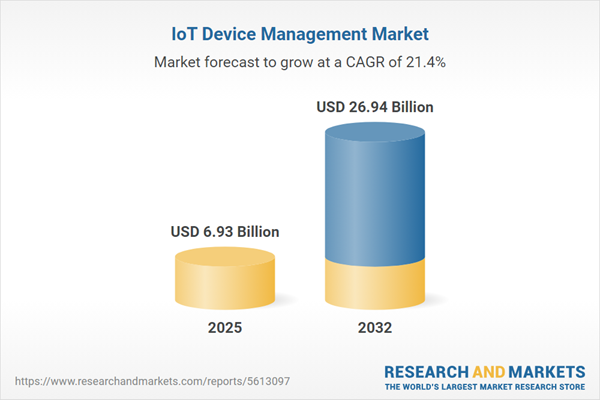Speak directly to the analyst to clarify any post sales queries you may have.
The IoT Device Management Market presents an evolving landscape shaped by rapid device proliferation, edge computing advances, and tightening regulatory demands. As enterprises expand digital transformation initiatives, the need for secure, streamlined, and predictive device management places growing emphasis on integrated platforms and strategic vendor partnerships.
Market Snapshot: Growth and Opportunity in the IoT Device Management Market
The IoT Device Management Market grew from USD 5.71 billion in 2024 to USD 6.93 billion in 2025. It is expected to continue growing at a CAGR of 21.39%, reaching USD 26.94 billion by 2032. Heightened investment in connected devices, rising edge deployments, and regulatory compliance are amplifying the demand for advanced device management capabilities. Decision-makers recognize these platforms as essential for scaling secure infrastructure and extracting actionable intelligence from expansive device fleets, especially in complex industrial and enterprise environments.
Scope & Segmentation: In-Depth Analysis Across the IoT Device Management Landscape
This comprehensive research report analyzes the IoT Device Management Market through multiple strategic lenses to support targeted decision-making. It covers:
- Component: Hardware (edge devices, gateways, sensors), Services (managed, professional), Software (connectivity management, device management platforms, security and analytics tools)
- Deployment Mode: Cloud, hybrid, on-premises
- Connectivity Technology: Bluetooth, cellular (4G, 5G), LPWAN (LoRaWAN, NB-IoT, Sigfox), Wi-Fi (Wi-Fi 4, Wi-Fi 5, Wi-Fi 6)
- End User Industry: Energy & utilities, healthcare, manufacturing, retail, transportation & logistics
- Application: Asset management, fleet management, predictive maintenance, smart metering
- Organization Size: Large enterprises, small and medium businesses
- Service Model: Managed services, professional services
- Region: Americas (North America: United States, Canada, Mexico; Latin America: Brazil, Argentina, Chile, Colombia, Peru), Europe, Middle East & Africa (Europe: United Kingdom, Germany, France, Russia, Italy, Spain, Netherlands, Sweden, Poland, Switzerland; Middle East: United Arab Emirates, Saudi Arabia, Qatar, Turkey, Israel; Africa: South Africa, Nigeria, Egypt, Kenya), Asia-Pacific (China, India, Japan, Australia, South Korea, Indonesia, Thailand, Malaysia, Singapore, Taiwan)
- Companies Analyzed: Amazon Web Services, Microsoft Corporation, IBM, PTC Inc., Siemens, Software AG, Cisco Systems, SAP, Bosch.IO, Arm Limited
Key Takeaways for Senior Decision-Makers
- Edge computing and AI integration are shifting device management from basic provisioning to predictive, real-time orchestration, supporting resilient operations and adaptive security.
- Regulatory pressures and cyber-risk exposure are accelerating adoption of unified management platforms that address transparency, auditability, and evolving compliance frameworks.
- Seamless integration with existing infrastructure is now a primary vendor selection criterion, reflecting a focus on lowering operational costs and maximizing ROI on previous investments.
- Regional maturity varies widely, with established tech hubs driving innovation, while emerging markets prioritize scalability and tailored connectivity for underserved scenarios.
- Competition is intensifying, marked by strategic alliances, acquisitions, and the rise of flexible models—including open source—to broaden accessibility and accelerate deployment cycles.
Tariff Impact: Navigating Cost Pressures and Supply Chain Realignments
Recent tariff policies in the United States have altered the strategic calculus for hardware sourcing and procurement. Increased duties on imported components are prompting organizations to streamline supply chains and shift toward domestic suppliers, leading to greater investment in localized assembly. Service providers and equipment vendors are responding with revised pricing models and deeper partnerships to mitigate cost volatility, highlighting the importance of device management solutions in optimizing asset value and sustaining continuity amid trade policy shifts.
Methodology & Data Sources Underpinning the IoT Device Management Market Analysis
Market intelligence is based on a rigorous methodology combining primary and secondary research, expert interviews, and structured data triangulation. Engagements with technology providers, industry stakeholders, and field experts validate emerging trends, while industry reports, technical papers, and regulatory literature supply valuable context. Peer reviews and advisory panels ensure robust, balanced insights for strategic planning.
Why This Report Matters
- Provides actionable analysis for aligning IoT device management investments with evolving enterprise transformation goals and regulatory requirements.
- Equips senior leaders with a strategic framework for evaluating vendor partnerships, segment opportunities, and risk mitigation amid market disruption.
- Delivers detailed segmentation to support the development of informed product, procurement, and operational roadmaps across industries and regions.
Conclusion
This report supports executive decision-making by clarifying how technology shifts, regulation, and regional differences intersect to shape the IoT Device Management Market. Senior leaders can use these insights to enhance resilience, guide investments, and drive sustainable value across the connected enterprise.
Additional Product Information:
- Purchase of this report includes 1 year online access with quarterly updates.
- This report can be updated on request. Please contact our Customer Experience team using the Ask a Question widget on our website.
Table of Contents
3. Executive Summary
4. Market Overview
7. Cumulative Impact of Artificial Intelligence 2025
Companies Mentioned
The companies profiled in this IoT Device Management market report include:- Amazon Web Services, Inc.
- Microsoft Corporation
- International Business Machines Corporation
- PTC Inc.
- Siemens Aktiengesellschaft
- Software AG International GmbH
- Cisco Systems, Inc.
- SAP SE
- Bosch.IO GmbH
- Arm Limited
Table Information
| Report Attribute | Details |
|---|---|
| No. of Pages | 187 |
| Published | November 2025 |
| Forecast Period | 2025 - 2032 |
| Estimated Market Value ( USD | $ 6.93 Billion |
| Forecasted Market Value ( USD | $ 26.94 Billion |
| Compound Annual Growth Rate | 21.3% |
| Regions Covered | Global |
| No. of Companies Mentioned | 11 |








